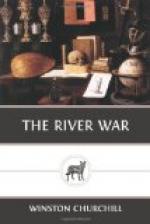Making a wide circuit to their left, and then swinging round to the right, so as to front facing the river, the brigade silently moved towards the enemy’s position, and at a quarter past six occupied the plateau in a crescent-shaped formation; the XIth Soudanese on the right, opposite the north-east corner of the village; the battery, escorted by the remaining half-battalion of the 3rd Egyptians, next; then the IXth in the centre, and the Xth Soudanese on the left flank. As the troops approached the watch-towers the Dervish outposts fell back and the force continued to advance until the edge of the plateau was reached. From here the whole scene was visible.
The day was just breaking, and the mist hung low and white over the steel-grey surface of the river. The outlines of the mud houses were sharply defined on this pale background. The Dervish riflemen crouched in the shelter trench that ran round the village. Their cavalry, perhaps a hundred strong, were falling in hurriedly on the sandy ground to the south near the ragged rocks. The curve of the hills, crowned with the dark line of the troops, completed and framed the picture. Within this small amphitheatre one of the minor dramas of war was now to be enacted.
At half past six the battery came into action, and after a few shells had been fired at the loopholed houses in the left centre of the position, a general advance was ordered. In excellent order the three Soudanese battalions, with General Hunter, Lieut.-Colonel MacDonald, and the other British officers on horseback in front of their line, advanced slowly down the hill, opening a destructive fire on the entrenchment. The distance was scarcely three hundred yards; but the crescent formation of the attack made the lines of advance converge, and before half the distance was covered the Xth were compelled to halt, lest the XIth Soudanese on the right flank should fire into them. The Dervishes remained silent until the troops were within a hundred yards, when they discharged two tremendous volleys, which were chiefly effective upon the halted battalion. Major Sidney, Lieutenant Fitzclarence, and a dozen men were shot dead. More than fifty men were wounded. All the Soudanese thereupon with a loud shout rushed upon the entrenchment, stormed it, and hunted the Dervishes into the houses. In the street-fighting which followed, the numbers of the troops prevailed. The advance scarcely paused until the river bank was reached, and by 7.30 Abu Hamed was in the possession of the Egyptian forces.
The Dervish horsemen, who had remained spectators near the southern crag during the attack, fled towards Berber as soon as they saw the attack successful. Scarcely any of the infantry escaped.
In this action, besides the two British officers, Major H. M. Sidney and Lieutenant E. Fitzclarence, 21 native soldiers were killed; 61 native soldiers were wounded.




